The Muskie Rod
The Muskie Rod
I've never loved a reel. Rods, however, are a different matter. The finest are an extension of ourselves, our connection to life beyond their tip.
My first muskie rod was a Heddon Muskie Special, a gift from a caring, widowed mother who couldn't afford it, but bought it anyway. Combined with a Pflueger Rocket casting reel, it was state-of-the art equipment in 1964. A solid-glass two-piece heavy-action casting rod, it was and is a fine piece of tackle that would still be adequate for most of my muskie fishing.
 Other than a few pool-cue-like trolling rods, there was little in the way of muskie rods on the market in Ontario back then. Though there were a few exceptions, species-specific rods didn't migrate in from saltwater in earnest until the early 1980s when steelhead anglers and bass pros began shaping the concept of the ideal rods for specific applications. Things like noodle rods and flipping sticks swept the market. And other than St. Croix, a company with roots in Wisconsin's muskie country, few manufacturers paid much attention to the niche market of muskie mania. Today, however, the array of tackle is truly staggering, and for many anglers, confusing. So, if you're a serious muskie or pike angler wanting to put together a system of rods to meet varying conditions or tactics or just see a new rod or two in your future, here are subjective guidelines to follow for your purchase.
Other than a few pool-cue-like trolling rods, there was little in the way of muskie rods on the market in Ontario back then. Though there were a few exceptions, species-specific rods didn't migrate in from saltwater in earnest until the early 1980s when steelhead anglers and bass pros began shaping the concept of the ideal rods for specific applications. Things like noodle rods and flipping sticks swept the market. And other than St. Croix, a company with roots in Wisconsin's muskie country, few manufacturers paid much attention to the niche market of muskie mania. Today, however, the array of tackle is truly staggering, and for many anglers, confusing. So, if you're a serious muskie or pike angler wanting to put together a system of rods to meet varying conditions or tactics or just see a new rod or two in your future, here are subjective guidelines to follow for your purchase.
First, don't buy a rod simply because it's endorsed by some well-known angler. Generally, all that means is you're buying a quality product that meets the needs of the pro. If your needs are the same, well and good; if not, you're buying a rod for the wrong reason. The pros don't actually design a rod. None that I know of are engineers. Instead, they give a detailed explanation of the way they plan to use a rod and their preferences for action, length, and cosmetics, then tech-types try to put all of this into a rod. There's nothing wrong with this; it's a good marriage of design and function which almost always produces a fine rod. Some two decades ago I helped Japanese technicians design a rod for Daiwa. It was a good buy for someone who spent most of his or her time casting Mepps Muskie Killers, Wood Vamps, and jointed Pikie Minnows on the Kawarthas, but as a big-water trolling rod for large-lipped crankbaits and for casting outsized jerkbaits, it was barely functional.
Buy rods that match the conditions and your fishing style. Don't try casting 1-ounce baits on a rod better suited to trolling 4-ounce rod thumpers. The rod won't have enough flex to store and release energy during a cast, affecting both accuracy and distance. By the same token, trolling rods that are overflexed don't transmit lure action effectively, and you'll spend a lot of time dragging around baits that have hooks fouled with weeds or other debris. Nor should you buy one of the longer rods if you do all of your fishing casting from a 14-foot aluminum boat. But if you do have a big boat with built-in rod storage, longer rods are nice tools for casting long distances with bulky but light bucktails or for spreading lines when you're trolling.
I suspect my original muskie rod was crafted for some grizzled old guide who trolled around in a 14- or 16-foot cedarstrip boat underpowered by a 5-, or at best, a 10 horsepower outboard. If the boat was seasoned properly, the angler's butt was probably barely above waterline. Hence, he -- and it was always a he in those days, since nice women only fished for trout, walleye, and bass -- needed a short rod to handle fish from the confines of a narrow boat. Thank God for progress. My two daughters could send a world-record 'lunge cowering in the weeds with one of their withering glances, and the sub-six-foot rod has been relegated to the same once-upon-a-time era.
There was a time, not so long ago, when muskie anglers were easily labelled. They were either casters, trollers, or complainers. The complainers could be casters who worked the tops of sunken islands or weedbeds when the fish were all 25 feet (7.6 m) down off the edge of deep-water shoals or who plumbed the depths while 40-pounders (18 kg) cruised the skinny water above a lake's densest weedbeds.
Muskie fishing, all fishing for that matter, has a lot to do with the old real estate maxim that success is nine-tenths location and one-tenth presentation. Simply put, you can't catch muskie where their aren't any. Nine-tenths of success is based on placing your lure in front of fish. The other tenth is selecting the right lure and drawing it through the water in a specific way to get a muskie to attack it. In fact, I'm inclined to believe that often the fish-producing qualities of a lure have more to do with its ability to spend most of its time at a specific water depth, rather than its action or colour. But I'm getting off track.
The point I'm trying to make is that a versatile muskie angler must be prepared to vary his or her tactics throughout the day, if for no other reason than to prevent boredom or burnout. Not many of us can cast a 10-inch Suick or Bobbie jerkbait for the 8 hours of a normal fishing day, nor remain sharp-witted throughout a full day of trolling.
 I begin my typical fishing day casting surface lures such as a Muskie Jitterbug over water often less than six feet deep. As the light rises, I'll move out to the edge of cover and start throwing big spinnerbaits or in-line spinners. From time to time, to vary my offering, I'll switch rods and work a jerkbait across the same cover. Muskie that pass up one lure will often smack the other. As the day matures and my arms begin to feel rubbery, I'll plumb the depths, concentrating on saddles, points, and deep-water humps.
I begin my typical fishing day casting surface lures such as a Muskie Jitterbug over water often less than six feet deep. As the light rises, I'll move out to the edge of cover and start throwing big spinnerbaits or in-line spinners. From time to time, to vary my offering, I'll switch rods and work a jerkbait across the same cover. Muskie that pass up one lure will often smack the other. As the day matures and my arms begin to feel rubbery, I'll plumb the depths, concentrating on saddles, points, and deep-water humps.
One rod won't do all of these things well, but a system of rods will. I want one rod to handle surface lures, spinnerbaits, and in-line spinners or light shallow-running crankbaits; another for jerkbaits up to 10 inches in length; and one more to handle the large-lipped trolling baits I use to work depths of 15 feet (4.6 m) or more. The first two rods will be mounted with quality casting reels and filled with 20- to 30-pound-test line, the last with 40-pound-test Dacron and a trolling reel.
But each of us has slightly different needs. With more than 50 current models of rods from well-respected manufacturers carrying the muskie designation, even the most finicky angler should be able to match technique to tackle.
Penn, Shakespeare, and Zebco (which markets the Quantum line) do not have a series of muskie rods. However, Penn which is marketed in Canada by Normark, produces two wire-line trolling rods, serious contenders with roller tips that accommodate 20- to 40- and 20- to 50-pound lines. Besides some of its saltwater rods, Shakespeare has a 7-foot Ugly Stik which handles 20-pound line. I've used it for much of my fishing on the Kawarthas during the last two seasons. In truth, any rod six to eight feet in length and with a long butt that can handle 20-pound-plus line and lures of 1-ounce or more could carry the muskie-rod designation.
Besides linear strength, tensile strength, sensitivity, action, power, guides, real seats, and handle selection discussed in the sidebar by long-time friend and muskie fisherman Bob Jones, both cost and cosmetics will factor into your decision. Nowhere is it written that a muskie rod shouldn't look good, nor will a $500 custom masterpiece necessarily catch more fish. But then, my mother always said, "Quality pays," and mothers never lie, at least mine never did.
A good rod should last at least a decade, even with plenty of use, so long as you clean it every once in a while and buy a well-made rod tube in which to transport it. Avoid leaving large lures hanging from rod tips during travel from one promising location to another. That's a good recipe for smashing a tip, even on the toughest rod.
Getting two muskie maniacs in a boat to agree on the right direction, let alone the perfect rod, is difficult, but with the list of choices now on the market, your chances of picking a great one have never been better.
This article is written with permission by Fish Ontario. Visit their website, http://www.fishontario.com, for more Ontario fishing information.
Fish Ontario
|
